We swore we wouldn’t inspect the hives all at once again, but after a temperament shift in the apiary this weekend we felt compelled to see what was going on with the bees.
On Saturday Mr. Curbstone was on the receiving end of some rather agitated guard bees. With four hives it was a little difficult to tell if the entire bee yard was on alert, or just one hive was the source of aggression. Regardless, Mr. Curbstone is currently nursing four bee stings.
The trouble started when he discovered a bee caught in the sleeve of his shirt while we were in the garden, but she stung him before we could reach her to free her. To avoid additional guards honing in on the alarm pheromone, he knew to go inside, rinse off, and change his shirt. We went back to working in the garden for a while. Then a few hours later, completely unprovoked, while standing some 8-10 yards from the hive stand, another guard locked Mr. Curbstone in her sights, stung him squarely on the eye brow, and then pursued him through the garden. Something seemed amiss.
The bees were clearly agitated that afternoon, and as we weren’t sure what set them off, we called it a day and left the garden area to get out of the firing line, and give them an opportunity to calm down.
With four hives, decreasing spring nectar flows, and the fact we’re still feeding the package colonies, we wondered as to whether or not there may be a robbing problem going on in our apiary contributing to increased aggression. Hive predation from rodents or skunks, robbing from bees and wasps, failing Queens, declining nectar resources, inclement weather, and residual alarm pheromones from bee stings, all can contribute to increased aggression in an apiary, so it was unclear at that moment exactly what the problem was.
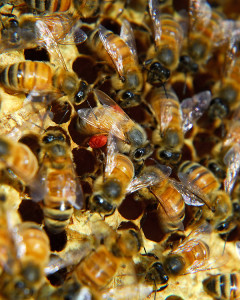
As some of the spring wildflowers fade, the bees have to travel further to forage for nectar and pollen
Clearly it was time to investigate further. On Sunday we had only intended to inspect our primary swarm hive, Salvia, but instead we decided to inspect all four hives to see if we could figure out what was going on.
We started with the smaller colonies first. Last we’d seen the Chamomile and Rosemary hives was when we removed the Queen cages. That was two weeks ago, and we had seen 1-2 day old eggs at that time in both hives, but it was too early to discern if the eggs being laid would develop into worker brood, or drones. During this inspection, assessing brood pattern, both overall distribution of brood, and ratios of workers:drones, would give us an idea as to whether or not our Queens in those colonies were well mated.
The Package Colonies
Chamomile Hive
We opened the Chamomile hive and were somewhat surprised to see that the bees hadn’t moved up much into the new hive body we placed two weeks ago. Four frames in fact were completely untouched, and the remaining four were only partially drawn out with comb, with some scant pollen stores, and some stored nectar.
After seeing how fast our swarm colony had built up earlier this spring, the difference was notable.
There was some question from the start about this hive, as these bees seemed to delay their initial orientation flights after they were hived, were slower to draw down syrup in the feeder, and overall entrance activity was significantly lower than the other package hived the same day.
We moved down to the lower hive body and found a small blob of burr comb on the top of the frames on the lower box, which we removed.
The second frame we pulled we sighted the Chamomile Queen again. Two inspections in a row, a new record for us!
We found capped brood on approximately 3 1/2 frames, and although it didn’t seem like a lot, the capped brood had an excellent pattern. Large patches of flat-capped worker brood, with just a few uncapped cells in between for the heater bees to help keep the brood warm.
One of the brood frames contained wall-to-wall brood, with no bands of capped honey, or pollen. Usually the bees will store capped honey in an outer ring on the frame, with a band of pollen, and then the brood in the center of the frame, so that frame stood out to us.
These bees were disadvantaged in that they had to draw all of their own comb from foundation as we had no drawn combs for them to start with. Perhaps eager to begin laying, the Queen simply filled that frame as soon as it was drawn, before there was space to store pollen and nectar reserves. The other brood frames had stores on the same frame, so we’re not too concerned, and expect that frame will appear more normal with the next round of egg-laying.
The package colonies were hived on May 7th, 22 days before this inspection, so we were very happy to already find baby bees inside this hive…
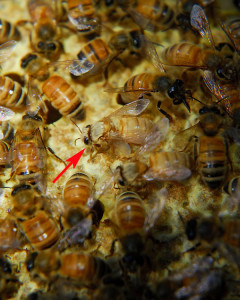
Recently hatched workers (red arrow) are pale in color compared to mature workers, and have an overall fuzzier appearance
…quite a few of them…
…and even found some bees just beginning to emerge.
So overall, the Chamomile hive, despite having relatively low population, seems at least to be Queen right, and the colony is progressing with new worker bees hatching. However, their neighbors, hived on the same day, are doing noticeably better.
Rosemary Hive
Comparing the Rosemary hive to Chamomile was nothing short of shocking. It was clear from the moment of taking the roof off the hive that the Rosemary hive has at least twice the population of its neighbor.
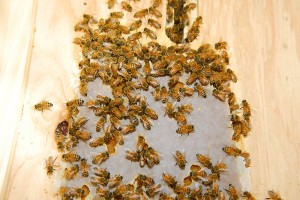
Before removing the inner cover we could see numerous bees feeding from the pollen patty in this hive
This significant difference in population is likely due to drift. Hiving two packages on the same day can make drift, where bees wander into a neighboring hive by mistake, significantly worse. It’s not something we’d do again, especially as our hives are currently all located on the same hive stand.
We’re not sure if the increased population is entirely due to drift from the large swarm colony on the other side of Rosemary, or if we also lost some population from the Chamomile package during their initial orientation, or both. Our suspicion is both.
It is obvious that the Rosemary hive has a much higher percentage of dark bees, not the homogeneous collection of blond package Italian bees observed in the Chamomile hive. Our swarm colonies have significant variation in color, but overall, the majority of bees are quite dark, implying that much of Rosemary’s boost in population has come from the swarm colony.
This isn’t bad, in that the swarm colony has more than enough population to spare, but this boost in population is clearly helping the Rosemary hive get off to a much stronger start.
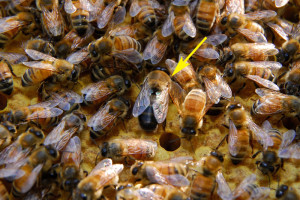
We found quite a few more drones (yellow arrow) in this hive, likely from the neighboring swarm hive
As we hived the packages on May 7th, the increase in population can’t be all ascribed to new bees hatching, as they only started to hatch within this last week.
Like Chamomile, Rosemary had some capped honey stores on the brood frames, with scant pollen, and plenty of capped and uncapped brood.
Rosemary was clearly ready for a third hive body, which we added as we wrapped up the inspection.
The Swarm Colonies
Lavender Hive (Afterswarm)
The afterswarm hive is continuing to grow since we last saw them. They’ve drawn comb on six of the eight new frames we gave them two weeks ago, and now have brood in both hive bodies.
There was plenty of capped brood in both hive bodies, and some newly hatched bees. Most of the capped brood was worker brood, but toward the bottom of a couple of the frames we did find little bits of drone brood too.
We also found one frame with some very young bee larva.
The only other interesting finding was that they seemed to be borrowing wax from one of the frames of foundation, as it was riddled with holes, with bees chewing out the wax. I suppose this is a case of why make it, when you can just move it?
We added a third hive body to this colony with eight new frames as they seem to be steadily growing, and no doubt will soon need the extra room.
Salvia Hive (Primary Swarm)
Starting out with bees, when they’re in one brood box, they’re quite easy to handle and inspect. Our swarm bees initially had a very calm demeanor, the frames were easy to move, and the hive easier to reassemble. Fast forward two months and it’s a slightly different story.
Other than adding hive bodies, we hadn’t inspected Salvia in a month, and it had been some time since we’d worked down to the lower brood chamber. The two drawn frames of comb we had used when hiving the swarm needed to be rotated to the edge so we can eventually replace them. As we’ve been considering whether or not to split this colony into two colonies, we also wanted to check for signs of swarm or supercedure cells. It’s not uncommon after a swarm finds a new home, for the Queen to be replaced soon thereafter.
As we had some unwelcome aggression the day before, and the hive is large enough that it would take time to do a thorough inspection, we decided that this time we should use the smoker.
We bought it months ago, but hadn’t used it until now, as we hadn’t felt the need. Some beekeepers never smoke their hives, but some of it really depends on the nature of the bees, and the beekeeper.
The smoke interferes with the bee’s sensory perception and ability to detect threats to the colony, but also, thinking there may be trouble in the hive, the bees gorge themselves on honey when smoked. If they need to vacate, these stores would serve them well while establishing a new colony. Gorging also causes them, in their post-prandial Thanksgiving-dinner-like state, to be more calm. The downside of not using a smoker when working bees is the colony can become increasingly aggressive with each hive manipulation. Over time this can result in colonies that are almost too aggressive to work. So as with other aspects of beekeeping you have to decide what works best for your bees in your bee yard.
For as fast as this colony was growing, we were surprised that the upper hive body placed two weeks ago was completely untouched. No comb drawn out at all. We removed that hive body and found plenty of bees in the 3rd box.
We removed this hive body and the one below it to get to the bottom box. Starting from the bottom, and working up, it’s easier to keep the majority of the population covered so you don’t have an entire open hive full of bees in your bees-iness during the whole inspection.
As we removed the hive body on top of the bottom box, we noticed we’d torn a small amount of burr drone comb that the bees had built under the bottom bar on one of the frames. Staring us square in the eye was a purple-eye stage drone pupa, approximately 17 days old.
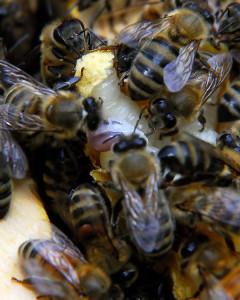
This happens in every hive at some point, where brace comb with larva or pupa gets torn when frames are moved
This is one of the disadvantages of not working down the hive regularly. However, it’s far less disruptive to the colony to occasionally lose a few drone pupa, than to work a hive every week just to prevent small blobs of burr comb between frames.
Except for the top hive body, the entire hive was wall to wall bees. Even using the smoker it was difficult to drive the bees around enough to see what we were doing.
The smoker was remarkably helpful for reassembling the hive though, helping to push the bees back down into the frames before re-stacking the hive bodies.
There was still a fair amount of drone brood throughout all three hive bodies, maybe 15-20% of the population, but what was more remarkable was the relative lack of food stores.

The two old frames used when we hived the swarm are where most of the drone brood is concentrated, suggesting these frames are no longer ideal for worker brood, and should be rotated out of the hive
Up to now this hive has usually had plenty of capped honey, uncapped nectar and pollen reserves. However, this time the outer frames that are often used as the hive pantry were completely empty. The brood frames did have some nectar and pollen, but considering the increase in population in this colony since it was hived at the end of March, the cupboard seemed relatively bare.
Perhaps this is why the bees were more agitated while we were gardening on Saturday. This colony is not short of field workers to forage for food, but they’re producing so much brood that they seem to be having a slight issue keeping up with demand.
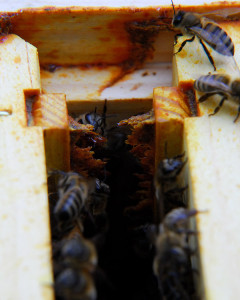
Propolis, a very sticky resin collected from plants, is used by bees to glue everything down in the hive
What this hive wasn’t short on was propolis! Icky sticky resinous goo that the bees use to stick everything down, or together, within the hive, or to fill cracks with. It makes moving frames a little more tricky, and everything a lot more sticky!
We saw no sign of swarm or supercedure cells this hive, which is good news. Overall there’s a slight increase in population, but not as much as we expected (probably due to drift into the neighboring Rosemary hive), and significant exhaustion of food reserves with this hive. We doubt their reserves were robbed, as this colony is formidable, but the hive entrance had been wide open up until Sunday, so it’s possible. It seems more likely that the sheer increase in population has caused them to use up much of the previously stored nectar and pollen from early spring, and they seem to be focusing on brood production, rather than honey stores.

Mutual feeding in bees is called 'trophallaxis'. Large colonies create a high demand for food rescources.
As we’re still waiting for an entire brood cycle to emerge from the neighboring package hives, we’re still feeding, but hope to cease supplemental feeding soon, we’d just like them to draw a few more frames of foundation first. In the meantime though, as Salvia seems short on pantry stores, and aggression in the bee yard was noticeable on Saturday, we’ve elected to resume feeding in Salvia until the package hives can have their feed removed. We’ve also reduced the hive entrance again on Salvia while we’re feeding to decrease the likelihood of robbing. Our plan is to then remove the feeders from all the hives at once.
We’ll leave the Lavender and Rosemary hives alone for a while as they seem to be doing just fine. The next inspection we’ll recheck the Chamomile hive to see how much their population is increasing. We’ll also check the upper hive body on Salvia to see if they are managing to draw that comb, and see if food stores are increasing. At that time we may elect to transfer a couple of frames of brood from Salvia to help decrease the population slightly, decreasing demand for food, and place those brood frames in the Chamomile hive to help bolster their population. We’ll have to wait and see how things are going during the next inspection though.

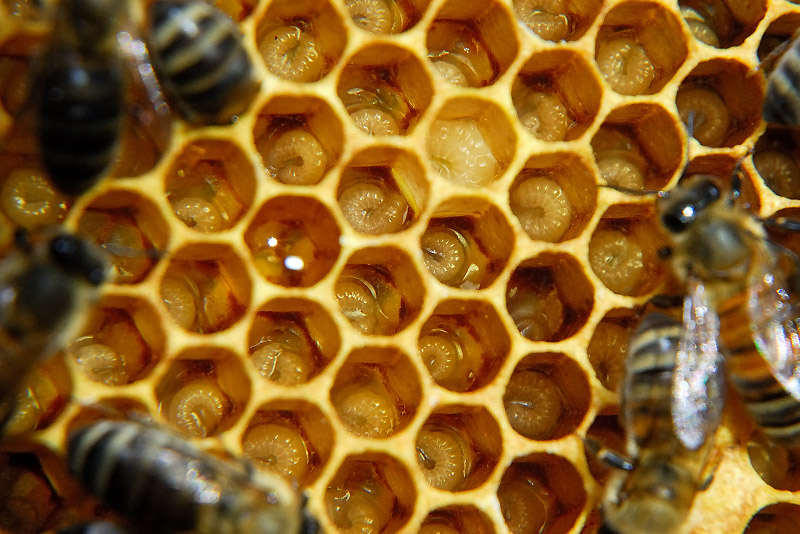
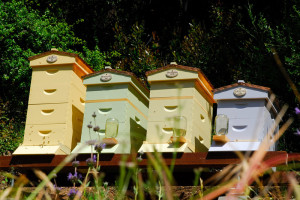
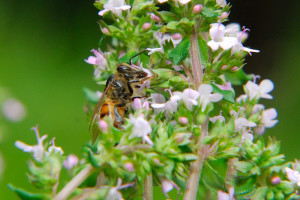
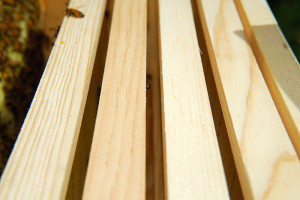
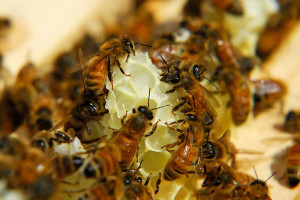
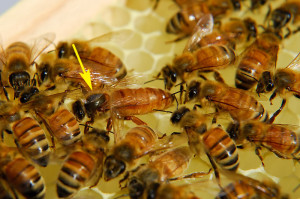


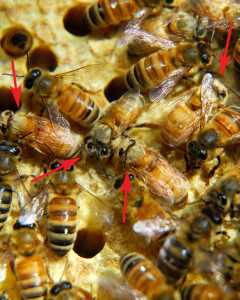
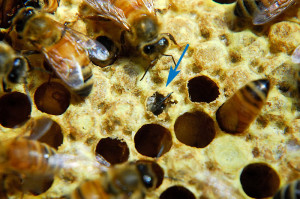

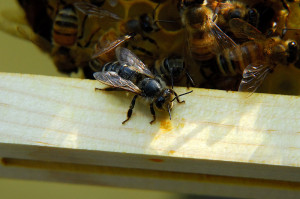
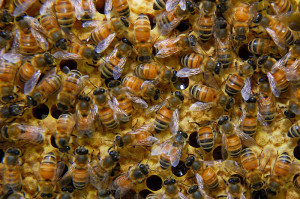


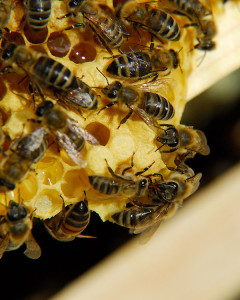
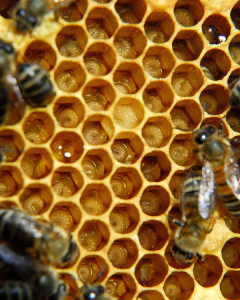
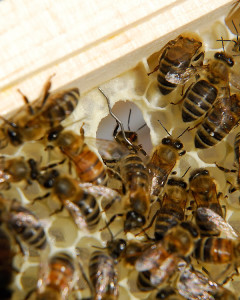
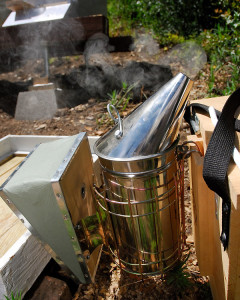
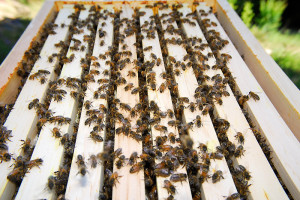
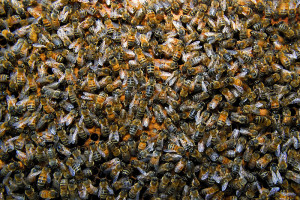








This is just so interesting! I loved seeing the baby bees and how different the bees from the swarm versus the package bees look. Sounds like for the most part things are going well with them. Hope the bees don’t take their aggression out on you or Mr. Curbstone again.
We’re hoping this was just the bees having a bad day, and that it’s not indicative of how they’ll be from now on. Otherwise things so far are going well!
Ouch! Too bad about Mr CV’s stings. The one on his face can’t be much fun.
It’s so interesting to see the different rates of development of the hives, given the same available resources (nectar, pollen).
I need to do another inspection of our hive this week. It’s been 15 days now since installing the package. I found eggs last week, so I know the queen is laying, though I didn’t find her last time. It’s been so hot here (95F today) that I need to get it done in the morning, and keep it quick.
His eye was pretty swollen the next day, although not as bad as I expect mine would have been. I’m bad enough with a mosquito bite on my eye lid.
I too find it quite interesting how every hive is different. Each colony seems to have its own dynamic, rate of growth, way of building up the interior of hive. I always knew bees were complex organisms, but I’m not sure I appreciated hive life as much before having bees here. Every time I open a hive, they teach me something new!
Clare, It’s much more complicated then I ever imagined. Makes me appreciate the local beekeeper’s honey costs. Poor Mr Curbstone~ gail
It’s probably not too complicated once you really know what you’re doing, but we’re still learning 😉 However, I do think the best beekeepers, at least of those I’ve met, do well in large part because they pay attention to, and learn to read their bees, and the bee’s needs. I must admit though, I’m with you on honey costs. Knowing what really goes into making a pound of honey, I think it’s under-priced. Those girls work hard for a living!
I love your bee posts! I always learn so much from them and I feel they’re much better than any beekeeping book out there.
Thanks Rachel. If nothing else I hope the photos are useful. Most bee books I looked at were woefully devoid of photographs (with the exception of books like Tautz’s ‘The Buzz About Bees’). I find it’s helpful for me to see what goes on in a hive, not just read about it. I’m also finding that for record keeping, taking photos of each hive as we work through it helps me remember what I actually saw before writing it up…it’s just hard taking photos when you’re wearing a veil 😛
So amazing…I read with rapt interest as you inspected each hive one by one. I am glad there was nothing seriously wrong with the hives. BTW…I really like your new layout.
Glad you enjoyed it! We were happy to find that all seems well, and most likely normal for this point in spring. Hopefully the bees will be happier to see us next time we’re in the garden 🙂
It does make sense that the bees would be building up populations and not being able to stockpile surplus food. I dread getting aggressive bees, since our urban backyard is so tiny.
I’m hoping this was just an anomalous event, and Mr. CV just had some residual alarm pheromone on him when he was stung on his eye brow. We don’t really want aggressive bees either, and so far they’ve been fine. The orientation of the hives above the garden though would make it impossible to be in the garden if our bees became really cranky, although if that happened, I think we’d re-queen 😉
Well I’m certainly exhausted after reading of your explorations! The hives look so pretty, like Victorian row houses in the City.
We were exhausted after inspecting four hives, and writing it up! I promise, the next bee update will be MUCH shorter 😛
Clare it really does sound like beekeeping is intensive work at times. I really do hope that giving them that extra feed will ease their aggression as I’m sure it wouldn’t be too pleasant to have to wear bee keeping gear while weeding. At least you have some space in Chamomile if you need it. Would you consider moving the chamomile hive next to the swarm hive? as I presume that’s where the Rosemary hive is just now.
That’s very astute Rosie. That’s the one other option I didn’t mention. We can indeed swap the position of the Rosemary and Chamomile hives. If new bees orienting to the Salvia hive are the ones drifting into Rosemary, then moving the hives would help build up Chamomile’s population, and balance the hives a little better. Also, when you switch hive position like that, the workers that are out in the field at the time the hives are moved will usually return to the hive in the same location as where they left. So if we swapped, the Rosemary field workers would come home to Chamomile, and vice versa, and providing they return with food, I expect the guard bees would let them in.
The advantage of moving brood over to Chamomile instead is it’s easier to move, but if the drift from one hive to the other continues, rotating hive position on the hive stand may make more sense.
Dear Clare – playing catchup with your posts from wildflowers to hungry bees. It’s rather like going to a museum and getting information overload – so much to look at and learn. But this post convinces me I could never keep bees – aside from the sudden bombardments, the care required is so intense.
p.s. belated happy 200th post! Note too you’re atahualpa-less with a clean, slick and broadsheet format that can cater to all your categories. Like the post intro slideshow on home page. Long live Curbstone Valley.
Fortunately bees don’t usually bombard the beekeeper, or anyone else. However, we wanted to be sure that if there was trouble in the hives, especially related to our management, that we took any necessary steps to correct any problems. As new beekeepers we know that our primary responsibility is to ensure we meet their needs. If our feeding two hives was contributing to robbing and aggression, then it’s up to us to fix it.
We are now Atahualpa-less. As a WP template it served us well for a couple of years, but some of the recent updates caused a few headaches, and the new update no longer supports custom PHP code. We also have had a problem with blog security due to some vulnerabilities in Atahualpa in recent months, which was making our web-host upset, so we decided it was time for a change.
Boy this is like watching Nature on PBS…so informative, fascinating and downright cool…thx for teaching us all about the bees we see in our garden and what they do when they leave us to go to their hives…
Thanks Donna. I’m glad that even non-beekeepers find these posts interesting. I think it’s easy in the market to look at a jar of honey and just assume that honey happens, but there’s so much more that goes on behind the scenes that I think most of us don’t even realize 😉
Amazingly informative, as always. Reading your accounts feels like good prep for our own beekeeping that is sure to come some season in the future.
Wow! It must be nice to see the wall to wall bees happily doing their thing. The photo is really impressive as well! It’s hard to keep a nice post short.
Ouch! But I guess it goes with the territory! I have learned a lot about bees from you. The other day I was out working in the garden and was surrounded by bees, happily buzzing from flower to flower. I thought then, they aren’t interested in me because they are too fat and happy from all the blooms. Now if they were hungry, it would have been a different story. Hunger can make one grumpy, whether you be bee or me!
Amazing! Everything I never knew I needed to know about beekeeping… and it was absolutely fascinating. I read every word and can’t wait for the next update. Thanks for charing, Clare.